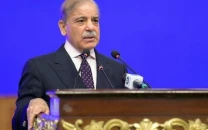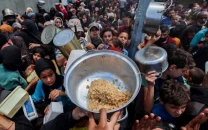Pakistan home to world's third-largest 'slave' population
Only India and China have more

India, China and Pakistan are home to the largest number of victims of modern-day slavery. PHOTO: FILE
From men made to work in factories, farms and fishing boats and women forced to sell sex to people exploited for their organs and children sent to beg or forced to marry, human trafficking is one of the fastest growing criminal enterprises.
North Korea, Eritrea and Burundi are estimated to have the world's highest rates of modern-day slavery, with India, China and Pakistan home to the largest number of victims, according to the United Nations and Walk Free Foundation.
The United Nations has designated July 30 World Day against Trafficking in Persons, with the world striving to meet a UN goal to end forced labour and modern slavery by 2030.
10 million slaves go missing from survey in India
Here are some key facts and figures about modern slavery and human trafficking worldwide.
People can be trafficked for various forms of exploitation such as prostitution, forced labour, begging, criminality, domestic servitude, forced marriage and organ removal.
The face of human trafficking is changing, with more children and men falling prey, and more victims trapped in forced labour than a decade ago, the UN says.
At least 40 million people are victims of modern slavery worldwide - with nearly 25 million trapped in forced labour and about 15 million in forced marriages.
Almost three-quarters are female - and one in four a child with modern-day slavery most prevalent in Africa followed by Asia and Pacific.
Eradicating the menace: ‘Those involved in bonded labour to face the music’
North Korea has the world's highest rate of slavery, with about one in 10 people enslaved, followed by Eritrea 9.3 %, Burundi 4%, Central African Republic 2.2%, Afghanistan 2.2%, Mauritania 2.1%, South Sudan 2%, Pakistan 1.7%, Cambodia 1.7% and Iran 1.6%.
India is home to the largest number of slaves globally, with 8 million, followed by China 3.86 million, Pakistan 3.19 million, North Korea 2.64 million, Nigeria 1.39 million, Iran 1.29 million, Indonesia 1.22 million, the Democratic Republic of the Congo 1 million, Russia 794,000 and the Philippines 784,000.
Human trafficking generates an estimated $150 billion each year in illicit profits for traffickers and slave masters.
The United Nations' latest global goals, the Sustainable Development Goals, passed by UN member states in 2015, call for the eradication by 2030 of forced labour, modern slavery and human trafficking, and an end to child labour.


















COMMENTS
Comments are moderated and generally will be posted if they are on-topic and not abusive.
For more information, please see our Comments FAQ